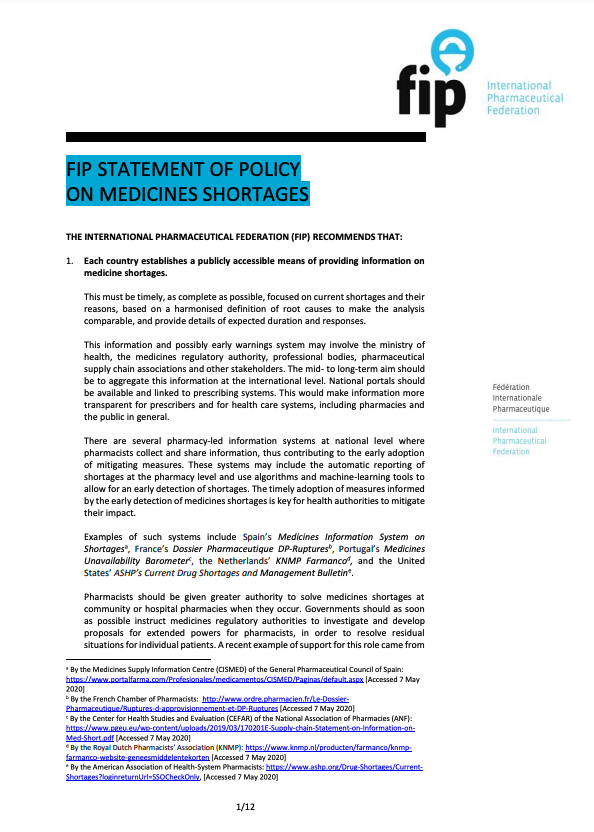

FIP Development Goal 18 Education & Workforce Element
Globally, we will have:
Strategies in place to widen access to medicines & services through a responsive, capable, available and well-distributed pharmaceutical workforce.
Mechanisms

FIP Development Goal 18 Practice Element
Globally, we will have:
Systems in place to optimise access to effective medicines and pharmaceutical care services through appropriate supply chains, quality standards, self-care & prevention services, and affordability and fair pricing policies.
Mechanisms

FIP Development Goal 18 Science Element
Globally, we will have:
Access to innovative science and information, new/innovative therapies, new delivery/ manufacturing processes.
Mechanisms





The 2020 FIP digital programme, entitled: Transforming Vaccination Globally and Regionally was the first FIP outcome-based online programme of its kind, which culminated in the signing of a FIP Commitment to Action on Improving Vaccination Coverage Through Pharmacies by FIP and member organisations to transform vaccinations globally and regionally. Building on the outcomes of the 2020 programme, the FIP 2021 digital programme focuses on supporting FIP members in accelerating programmes of equity, access and sustainability of vaccinations through policy development and implementation.

The FIP Development Goals Digital Programme “Setting goals for the decade ahead” is a comprehensive online event series providing coverage of the 21 goals over 21 events in 2021. The Programme aims to provide description, direction and context for each specific goal, with a global plan for the decade ahead and how each nation, within each region can identify and prioritise which goals are the priorities and how the goals can support developments and transformation for them.
The 2nd episode of the FIP “Setting goals for the decade ahead” programme explores FIP Development Goal 18: Access to medicines, devices and services. Through this goal, we aim to optimise access to effective and innovative medicines, medical devices and pharmaceutical care through frameworks, education and training. Together we will showcase the importance of access to medicines, devices and services as a means to attaining better health for all.
Event outcomes:
1. Describe the FIP Development Goals and explain the components of DG 18 (and its three elements: workforce & education, science and practice).
2. Showcase the FIP tools, evidence, and resources to support DG 18 implementation across the three elements.
3. Identify priorities across practice, science, and workforce & education within DG 18
4. Engage our members in an activity to support monitoring and evaluation of the Goal through data evidence

Traditionally, the distribution of medicines to consumers has been organized through heavily regulated networks of physical pharmacies. The strict regulation of market structure has been in place to ensure the safety, accessibility and affordability of medicines, but it has also limited competition in the pharmacy sector. Nowadays, the regulation of pharmacies differs between countries, and this has created different market conditions for online pharmacies to operate.
In some countries the online sales of medicines have grown considerably during the recent years as consumers have become more accustomed to e-commerce. More lately the Covid-19 pandemic has dramatically shaped the e-commerce landscape. Due to the pandemic, the demand for online services of pharmacies has increased significantly in many countries. It is also likely that this has changed preferences for some consumers permanently and demand should therefore remain at a higher level in the future.
Increased cooperation between countries in developing regulation of online pharmacies is needed, according to the report, “Online pharmacy operations and distribution of medicines”, which will be published by the International Pharmaceutical Federation (FIP) on December 8th, 2021.

This event will focus on the role that pharmacists can play in providing pharmaceutical care for people with hearing impairment or a disability linked to hearing loss. Pharmacists must provide clear messages and adapt their communication strategies to this particular population group to ensure optimal use of medicines and medical devices, and they need to have the knowledge and skills to do so. Also, people with hearing loss face different challenges and this problem becomes more relevant with age. Pharmacists can support patients in detecting early signs of hearing loss and taking the appropriate actions.

FIP’s Hospital Pharmacy Section is organising a webinar on “Good storage and distribution practices for pharmaceutical products in hospitals”.
The correct storage and distribution and the continuous improvement of the processes involved in the supply chain from the acquisition to the administration or use of pharmaceutical products in hospitals, have a direct economic impact and improves quality assurance in patients care.
Learning objectives:
1. Understand variables that affect the stability of pharmaceutical products.
2. Understand storage and distribution processes.
3. Evaluate good storage and distribution practices that improves quality processes.
4. Highlight new technologies that benefit good practices for pharmaceutical products.
The following FIP programmes of work and structures support the implementation of this Goal: